Home / UV-Vis Spectroscopy: Absorbance of Carbonyls
Spectroscopy
UV-Vis Spectroscopy: Absorbance of Carbonyls
Last updated: October 31st, 2022 |
UV-Vis Spectroscopy Of Carbonyls (C=O Bonds)
UV-Visible spectroscopy is not just about C-C pi bonds. C-O pi bonds can absorb UV light as well!
Table of Contents
- A Quick Review on UV-Vis
- C=O Bonds Show An Absorbance Maximum Around 300 nm
- This is actually a n-> pi* transition, not pi to pi* (!)
- Wait. Why not pi to pi* ?
- Carbonyls also participate in conjugation
- Summary: UV-Vis Spectroscopy Of Carbonyls
- Notes
1. A Quick Review Of What We’ve Learned So Far About UV-Vis
In our last post we showed that molecules with C-C pi (π) bonds absorb light in the UV-visible region, which promotes electrons from (bonding) π orbitals to (anti bonding) π* orbitals.
We saw that
- the energy required for the transition depends mostly on the extent of conjugation (i.e. the number of consecutive pi bonds, roughly speaking).
- an alkene with little or no conjugation (e.g. ethene, CH2=CH2) possesses a large energy gap (ΔE) between the bonding and anti bonding orbitals, which requires more energetic (shorter wavelength) photons for excitation. For ethene, maximum absorbance occurs at about 170 nm, in the UV region.
- as conjugation increases, the energy gap ΔE decreases, pushing the wavelength of maximum absorbance (λmax) toward the visible (less energetic photons, longer wavelength) . For example, β-carotene (the orange pigment in carrots) with 11 conjugated pi bonds, absorbs in the visible (λmax = 470 nm).
Because the post was so damn long, we never got around to addressing a key question: does this apply to other types of pi bonds as well?
For example, do C=O pi bonds also absorb light in the UV/visible region?
- The short answer is: yes.
- The medium sized answer is: yes, but the main transition of interest is not a pi-pi* transition – it’s slightly different.
The long answer is.. well, here’s the long answer.
2. Absorbance of C=O bonds Show A Maximum Around 300 nm
Let’s start with one of the simplest compounds with a C=O bond: 2-propanone, otherwise known as acetone.
Question: Does acetone absorb UV or visible light?
Answer: You betcha. Here’s the UV-Vis absorption spectrum for 2-propanone (acetone).
[The key piece of information to glean from that spectrum is that there is an absorbance maximum at about 275 nm, in the ultraviolet.]
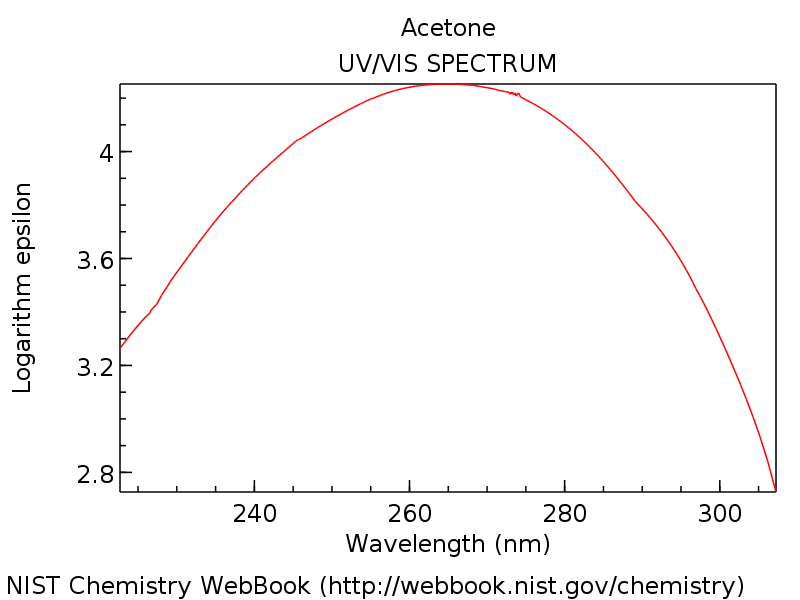
If you have an astonishingly good memory you may recall from the last post (or from my introduction above) that the absorption max for ethene (CH2=CH2) is about 170 nm.
An absorption around 275 nm means that longer wavelength and therefore less energetic photons are required for this transition.
Doesn’t that seem weird?
If anything, C=O π bonds are stronger than C=C π bonds. [You can look it up]. Wouldn’t you reasonably expect *more* energy to be required to promote an electron from pi(π) to pi* (π*)?
What gives?
Now: as we’ll see in a minute, there is a pi to pi* ( π→π*) transition for acetone in the UV, but that peak at 275 nm is NOT a pi to pi* transition. It’s a transition from a non-bonding orbital (n) to the pi* orbital (n→π*).
3. Carbonyl (C=O) Groups Tend To Show Weak Absorbances At (Roughly) 300 nm That Correspond To Transitions Between Non-Bonding Orbitals and Pi* Orbitals
Huh? Let’s look at a simple molecular orbital drawing of acetone.
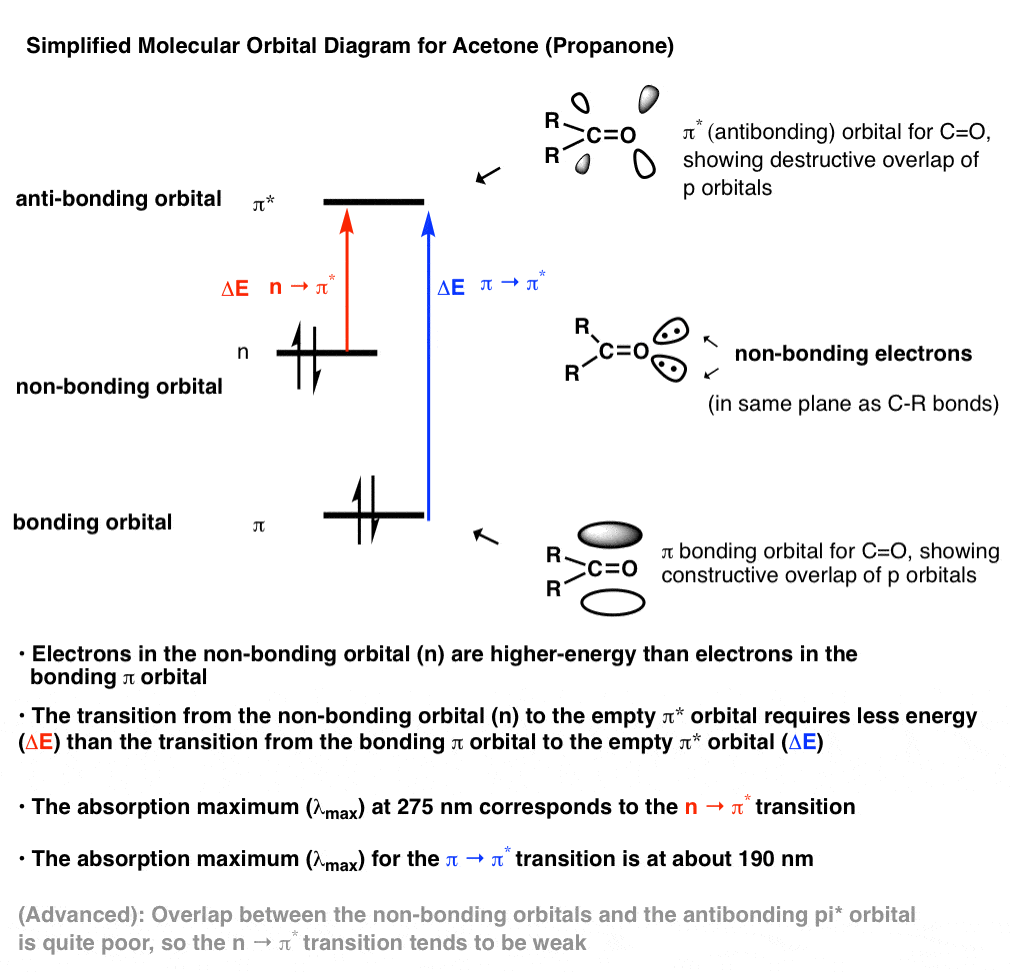
[This is a somewhat simplified picture. For a more detailed MO diagram for that also includes a more thorough discussion about the nature of the non-bonding orbitals, I highly recommend Reusch’s online textbook entry here. ]
A few important things to note:
- Carbonyl groups contain non-bonding electrons that are in an orbital intermediate in energy between the bonding pi orbital and the anti bonding pi* orbital. These orbitals are absent in typical alkenes such as ethylene [CH2=CH2] [note 1]
- Being higher in energy, transitions between electrons in the non-bonding orbital to the pi* orbital have a smaller ΔE and therefore absorb at longer wavelength.
- It is this (n→π*) transition which is responsible for the peak at around 275 nm.
4. What About Pi to Pi* Transitions for C=O?
So what about the pi to pi* transition? Doesn’t that happen too?
Glad you asked. If you take a quick look back at the UV-Vis absorption spectrum of acetone, above, you’ll note that the X-axis gets cut off around 240 nm or so. There’s a reason for that (mwah-ah-ah).
If you zoom out, you’ll see that there’s a much stronger transition around 190 nm. [I went looking for a decent full-size UV spectrum of acetone, and the diagram below is the best I could find. I didn’t make this image and it is not my intellectual property. I found it here. ]
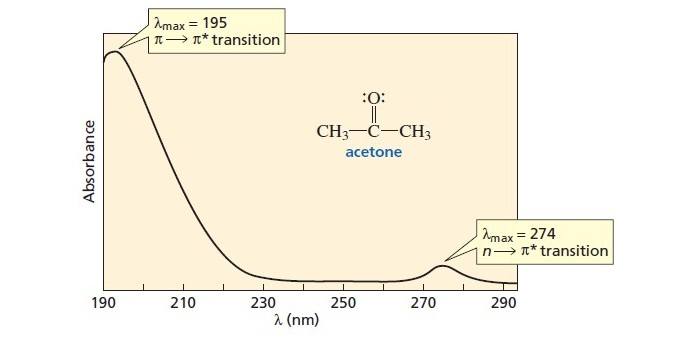
So as it turns out, that “peak” at 275 nm (n→π*) we were looking at turns out to be a molehill, next to the (π→π*) mountain at about 195 nm in the deeper UV.
In other words, the (n→π*) transition at 275 nm that we’ve spent so much time talking about is very weak relative to the (π→π*) transition. [sometimes a term called “epsilon, ε” is used to denote this difference in magnitude of absorption].
Why might that be? It has to do with differences in orbital overlap. In order for an electron to transition from one orbital to another, two conditions must be met.
- First, as previously discussed, the orbital has to interact with a photon of appropriate energy ΔE.
- Second, there has to be significant overlap between the orbitals in space. We generally don’t discuss this for (π→π*) and (σ→σ*) transitions because each pair of bonding and anti bonding orbitals occupies the same region of space. If you look back to the diagram for the location of the n orbitals in acetone compared to the location of the pi* orbitals, you might notice that they are essentially at right angles to each other. Poor orbital overlap means that even if the electron has sufficient energy ΔE to make the transition, the transition is considerably less likely to occur since the excited electron will be less likely to be occupying an area of space corresponding to the higher-energy orbital. [Extra detail: you might recall that orbitals are 3-dimensional volumes where the probability of encountering an electron is 95%. Therefore, there is some electron density outside of the volumes we typically consider “orbitals”]
5. Carbonyls Also Participate in Conjugation
Carbonyls can also participate in conjugation with C-C pi bonds. This leads to an increase in the overall λmax of the molecule. For instance, the absorbance of the alkene 2-methyl pent-2-ene is below 200 nm, as is the π→π* absorbance of 4-methyl pentane-2-one (below).
In mesityl oxide, where the alkene and C=O group are in conjugation with each other, the absorption maximum moves to longer wavelength at 228 nm. This is similar to the difference between the absorbance of ethene (174 nm) and butadiene (217 nm).
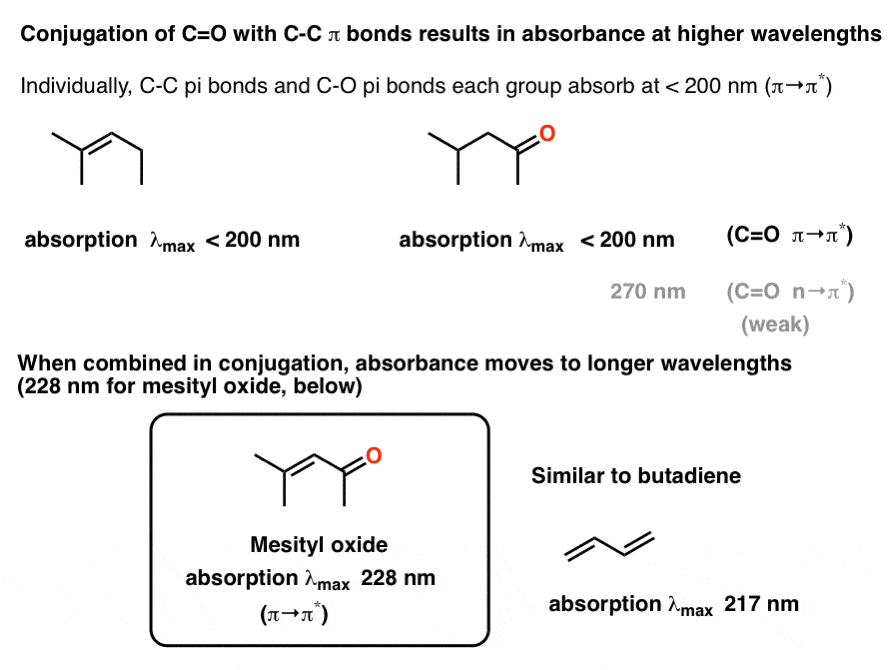
NoteThe absorbance maximum can be sensitive to the identity of the solvent as well as the identity of the substituents on the alkene. [Note 2].
6. Summary: UV-Vis Spectroscopy Of Carbonyls
Absorbance in the rough neighbourhood of 270-300 nm is common for molecules containing a C=O group (such as ketones and aldehydes) and this corresponds to a (n→π*) transition.
These absorbances tend to be weak, relative to (π→π*) transitions. Still, observing this absorbance can be an important clue in the structure determination of unknown compounds.
In the next post we’ll go into practical details of using UV-Vis in structure determination.
[Again, for a more in depth look on the subject of C=O absorbance, go to Reusch. We’re really skimming the surface here, but it is enough for our purposes.]
Notes
Related Articles
Note 1. It should be noted that non-bonding orbitals are present in species such as the allyl cation, allyl anion, and other ions of odd-numbered pi systems.
Note 2. For carbonyls, generally more polar solvents lead to higher λmax values, as does the presence of substituents (such as methyl groups) on the alkene.
Bonus Topic: Azo Dyes
Since we’re on the subject, let’s briefly explore another system where both n→π* and π→π* transitions are observed: azo dyes.
Azo dyes are the kind of thing that you’ve likely seen a million times without specifically knowing what they are.
For example, the yellow color of highway markings? That’s Pigment Yellow 10.

Azo dyes are commonly used in colouring textiles, plastics, and many other substances not intended for human consumption (they’re generally banned as food additives).
The key structural feature of an azo compound is a N=N linkage. One of the simplest azo compounds is azobenzene, where each nitrogen is connected to an aromatic ring. Slight modifications to the benzene ring can dramatically modify the color of the molecule. Aniline Yellow, discovered in 1861, was the first azo compound to find commercial use as a dye, and countless derivatives of azobenzene have been synthesized since then. [The synthesis is via diazo coupling – we won’t get into that here].

Here’s the UV-Vis spectrum of Aniline Yellow, as calculated by ChemTube 3D.

Note how it is qualitatively similar to that of acetone: a strong absorbance on the left (towards the UV) and a weak absorbance on the right (towards the visible).
In contrast to acetone, however, where the weak absorbance is at 260 nm, the weak absorbance in Aniline Yellow is in the visible region of the spectrum at about 460 nm. It is this absorbance at 460 nm that is responsible for the color of Aniline Yellow.
By analogy to acetone, the weak transition is an (n→π*) transition and the strong transition around 360 nm is a π→π* transition.
Photoisomerization
What’s even more interesting about azobenzenes and their derivatives (e.g. Aniline Yellow) is the phenomenon of photoisomerization, where absorption of specific frequencies of light can lead to isomerization of trans isomers to cis isomers and vice-versa.
Absorbance of UV light by trans-azobenzene (a π→π* transition) leads to isomerization to cis-azobenzene. Contrariwise, absorbance of visible light (blue light) by cis-azobenzene (the n→π* transition) results in conversion back to the trans-isomer [so does leaving cis-azobenzene in the dark, a process known as thermal relaxation]. The mechanism for this process is still not completely settled.
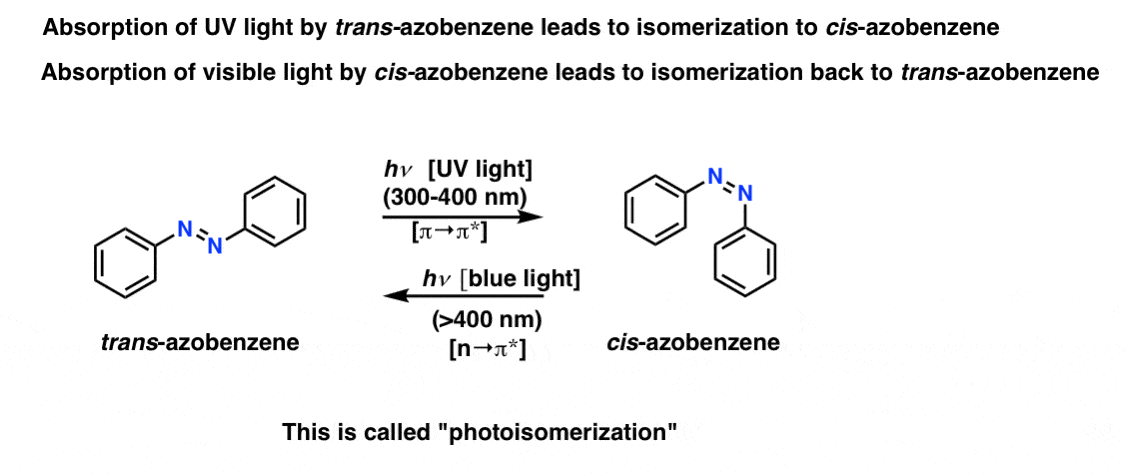
Pretty neat that you can target a specific isomer merely by changing the frequency of light.
00 General Chemistry Review
01 Bonding, Structure, and Resonance
- How Do We Know Methane (CH4) Is Tetrahedral?
- Hybrid Orbitals and Hybridization
- How To Determine Hybridization: A Shortcut
- Orbital Hybridization And Bond Strengths
- Sigma bonds come in six varieties: Pi bonds come in one
- A Key Skill: How to Calculate Formal Charge
- The Four Intermolecular Forces and How They Affect Boiling Points
- 3 Trends That Affect Boiling Points
- How To Use Electronegativity To Determine Electron Density (and why NOT to trust formal charge)
- Introduction to Resonance
- How To Use Curved Arrows To Interchange Resonance Forms
- Evaluating Resonance Forms (1) - The Rule of Least Charges
- How To Find The Best Resonance Structure By Applying Electronegativity
- Evaluating Resonance Structures With Negative Charges
- Evaluating Resonance Structures With Positive Charge
- Exploring Resonance: Pi-Donation
- Exploring Resonance: Pi-acceptors
- In Summary: Evaluating Resonance Structures
- Drawing Resonance Structures: 3 Common Mistakes To Avoid
- How to apply electronegativity and resonance to understand reactivity
- Bond Hybridization Practice
- Structure and Bonding Practice Quizzes
- Resonance Structures Practice
02 Acid Base Reactions
- Introduction to Acid-Base Reactions
- Acid Base Reactions In Organic Chemistry
- The Stronger The Acid, The Weaker The Conjugate Base
- Walkthrough of Acid-Base Reactions (3) - Acidity Trends
- Five Key Factors That Influence Acidity
- Acid-Base Reactions: Introducing Ka and pKa
- How to Use a pKa Table
- The pKa Table Is Your Friend
- A Handy Rule of Thumb for Acid-Base Reactions
- Acid Base Reactions Are Fast
- pKa Values Span 60 Orders Of Magnitude
- How Protonation and Deprotonation Affect Reactivity
- Acid Base Practice Problems
03 Alkanes and Nomenclature
- Meet the (Most Important) Functional Groups
- Condensed Formulas: Deciphering What the Brackets Mean
- Hidden Hydrogens, Hidden Lone Pairs, Hidden Counterions
- Don't Be Futyl, Learn The Butyls
- Primary, Secondary, Tertiary, Quaternary In Organic Chemistry
- Branching, and Its Affect On Melting and Boiling Points
- The Many, Many Ways of Drawing Butane
- Wedge And Dash Convention For Tetrahedral Carbon
- Common Mistakes in Organic Chemistry: Pentavalent Carbon
- Table of Functional Group Priorities for Nomenclature
- Summary Sheet - Alkane Nomenclature
- Organic Chemistry IUPAC Nomenclature Demystified With A Simple Puzzle Piece Approach
- Boiling Point Quizzes
- Organic Chemistry Nomenclature Quizzes
04 Conformations and Cycloalkanes
- Staggered vs Eclipsed Conformations of Ethane
- Conformational Isomers of Propane
- Newman Projection of Butane (and Gauche Conformation)
- Introduction to Cycloalkanes
- Geometric Isomers In Small Rings: Cis And Trans Cycloalkanes
- Calculation of Ring Strain In Cycloalkanes
- Cycloalkanes - Ring Strain In Cyclopropane And Cyclobutane
- Cyclohexane Conformations
- Cyclohexane Chair Conformation: An Aerial Tour
- How To Draw The Cyclohexane Chair Conformation
- The Cyclohexane Chair Flip
- The Cyclohexane Chair Flip - Energy Diagram
- Substituted Cyclohexanes - Axial vs Equatorial
- Ranking The Bulkiness Of Substituents On Cyclohexanes: "A-Values"
- Cyclohexane Chair Conformation Stability: Which One Is Lower Energy?
- Fused Rings - Cis-Decalin and Trans-Decalin
- Naming Bicyclic Compounds - Fused, Bridged, and Spiro
- Bredt's Rule (And Summary of Cycloalkanes)
- Newman Projection Practice
- Cycloalkanes Practice Problems
05 A Primer On Organic Reactions
- The Most Important Question To Ask When Learning a New Reaction
- Curved Arrows (for reactions)
- Nucleophiles and Electrophiles
- The Three Classes of Nucleophiles
- Nucleophilicity vs. Basicity
- What Makes A Good Nucleophile?
- What Makes A Good Leaving Group?
- 3 Factors That Stabilize Carbocations
- Equilibrium and Energy Relationships
- 7 Factors that stabilize negative charge in organic chemistry
- 7 Factors That Stabilize Positive Charge in Organic Chemistry
- What's a Transition State?
- Hammond's Postulate
- Learning Organic Chemistry Reactions: A Checklist (PDF)
- Introduction to Oxidative Cleavage Reactions
06 Free Radical Reactions
- Bond Dissociation Energies = Homolytic Cleavage
- Free Radical Reactions
- 3 Factors That Stabilize Free Radicals
- What Factors Destabilize Free Radicals?
- Bond Strengths And Radical Stability
- Free Radical Initiation: Why Is "Light" Or "Heat" Required?
- Initiation, Propagation, Termination
- Monochlorination Products Of Propane, Pentane, And Other Alkanes
- Selectivity In Free Radical Reactions
- Selectivity in Free Radical Reactions: Bromination vs. Chlorination
- Halogenation At Tiffany's
- Allylic Bromination
- Bonus Topic: Allylic Rearrangements
- In Summary: Free Radicals
- Synthesis (2) - Reactions of Alkanes
- Free Radicals Practice Quizzes
07 Stereochemistry and Chirality
- Types of Isomers: Constitutional Isomers, Stereoisomers, Enantiomers, and Diastereomers
- How To Draw The Enantiomer Of A Chiral Molecule
- How To Draw A Bond Rotation
- Introduction to Assigning (R) and (S): The Cahn-Ingold-Prelog Rules
- Assigning Cahn-Ingold-Prelog (CIP) Priorities (2) - The Method of Dots
- Enantiomers vs Diastereomers vs The Same? Two Methods For Solving Problems
- Assigning R/S To Newman Projections (And Converting Newman To Line Diagrams)
- How To Determine R and S Configurations On A Fischer Projection
- The Meso Trap
- Optical Rotation, Optical Activity, and Specific Rotation
- Optical Purity and Enantiomeric Excess
- What's a Racemic Mixture?
- Chiral Allenes And Chiral Axes
- Stereochemistry Practice Problems and Quizzes
08 Substitution Reactions
- Nucleophilic Substitution Reactions - Introduction
- Two Types of Nucleophilic Substitution Reactions
- The SN2 Mechanism
- Why the SN2 Reaction Is Powerful
- The SN1 Mechanism
- The Conjugate Acid Is A Better Leaving Group
- Comparing the SN1 and SN2 Reactions
- Polar Protic? Polar Aprotic? Nonpolar? All About Solvents
- Steric Hindrance is Like a Fat Goalie
- Common Blind Spot: Intramolecular Reactions
- Substitution Practice - SN1
- Substitution Practice - SN2
09 Elimination Reactions
- Elimination Reactions (1): Introduction And The Key Pattern
- Elimination Reactions (2): The Zaitsev Rule
- Elimination Reactions Are Favored By Heat
- Two Elimination Reaction Patterns
- The E1 Reaction
- The E2 Mechanism
- E1 vs E2: Comparing the E1 and E2 Reactions
- Antiperiplanar Relationships: The E2 Reaction and Cyclohexane Rings
- Bulky Bases in Elimination Reactions
- Comparing the E1 vs SN1 Reactions
- Elimination (E1) Reactions With Rearrangements
- E1cB - Elimination (Unimolecular) Conjugate Base
- Elimination (E1) Practice Problems And Solutions
- Elimination (E2) Practice Problems and Solutions
10 Rearrangements
11 SN1/SN2/E1/E2 Decision
- Identifying Where Substitution and Elimination Reactions Happen
- Deciding SN1/SN2/E1/E2 (1) - The Substrate
- Deciding SN1/SN2/E1/E2 (2) - The Nucleophile/Base
- SN1 vs E1 and SN2 vs E2 : The Temperature
- Deciding SN1/SN2/E1/E2 - The Solvent
- Wrapup: The Key Factors For Determining SN1/SN2/E1/E2
- Alkyl Halide Reaction Map And Summary
- SN1 SN2 E1 E2 Practice Problems
12 Alkene Reactions
- E and Z Notation For Alkenes (+ Cis/Trans)
- Alkene Stability
- Alkene Addition Reactions: "Regioselectivity" and "Stereoselectivity" (Syn/Anti)
- Stereoselective and Stereospecific Reactions
- Hydrohalogenation of Alkenes and Markovnikov's Rule
- Hydration of Alkenes With Aqueous Acid
- Rearrangements in Alkene Addition Reactions
- Halogenation of Alkenes and Halohydrin Formation
- Oxymercuration Demercuration of Alkenes
- Hydroboration Oxidation of Alkenes
- m-CPBA (meta-chloroperoxybenzoic acid)
- OsO4 (Osmium Tetroxide) for Dihydroxylation of Alkenes
- Palladium on Carbon (Pd/C) for Catalytic Hydrogenation of Alkenes
- Cyclopropanation of Alkenes
- A Fourth Alkene Addition Pattern - Free Radical Addition
- Alkene Reactions: Ozonolysis
- Summary: Three Key Families Of Alkene Reaction Mechanisms
- Synthesis (4) - Alkene Reaction Map, Including Alkyl Halide Reactions
- Alkene Reactions Practice Problems
13 Alkyne Reactions
- Acetylides from Alkynes, And Substitution Reactions of Acetylides
- Partial Reduction of Alkynes With Lindlar's Catalyst
- Partial Reduction of Alkynes With Na/NH3 To Obtain Trans Alkenes
- Alkyne Hydroboration With "R2BH"
- Hydration and Oxymercuration of Alkynes
- Hydrohalogenation of Alkynes
- Alkyne Halogenation: Bromination, Chlorination, and Iodination of Alkynes
- Alkyne Reactions - The "Concerted" Pathway
- Alkenes To Alkynes Via Halogenation And Elimination Reactions
- Alkynes Are A Blank Canvas
- Synthesis (5) - Reactions of Alkynes
- Alkyne Reactions Practice Problems With Answers
14 Alcohols, Epoxides and Ethers
- Alcohols - Nomenclature and Properties
- Alcohols Can Act As Acids Or Bases (And Why It Matters)
- Alcohols - Acidity and Basicity
- The Williamson Ether Synthesis
- Ethers From Alkenes, Tertiary Alkyl Halides and Alkoxymercuration
- Alcohols To Ethers via Acid Catalysis
- Cleavage Of Ethers With Acid
- Epoxides - The Outlier Of The Ether Family
- Opening of Epoxides With Acid
- Epoxide Ring Opening With Base
- Making Alkyl Halides From Alcohols
- Tosylates And Mesylates
- PBr3 and SOCl2
- Elimination Reactions of Alcohols
- Elimination of Alcohols To Alkenes With POCl3
- Alcohol Oxidation: "Strong" and "Weak" Oxidants
- Demystifying The Mechanisms of Alcohol Oxidations
- Protecting Groups For Alcohols
- Thiols And Thioethers
- Calculating the oxidation state of a carbon
- Oxidation and Reduction in Organic Chemistry
- Oxidation Ladders
- SOCl2 Mechanism For Alcohols To Alkyl Halides: SN2 versus SNi
- Alcohol Reactions Roadmap (PDF)
- Alcohol Reaction Practice Problems
- Epoxide Reaction Quizzes
- Oxidation and Reduction Practice Quizzes
15 Organometallics
- What's An Organometallic?
- Formation of Grignard and Organolithium Reagents
- Organometallics Are Strong Bases
- Reactions of Grignard Reagents
- Protecting Groups In Grignard Reactions
- Synthesis Problems Involving Grignard Reagents
- Grignard Reactions And Synthesis (2)
- Organocuprates (Gilman Reagents): How They're Made
- Gilman Reagents (Organocuprates): What They're Used For
- The Heck, Suzuki, and Olefin Metathesis Reactions (And Why They Don't Belong In Most Introductory Organic Chemistry Courses)
- Reaction Map: Reactions of Organometallics
- Grignard Practice Problems
16 Spectroscopy
- Degrees of Unsaturation (or IHD, Index of Hydrogen Deficiency)
- Conjugation And Color (+ How Bleach Works)
- Introduction To UV-Vis Spectroscopy
- UV-Vis Spectroscopy: Absorbance of Carbonyls
- UV-Vis Spectroscopy: Practice Questions
- Bond Vibrations, Infrared Spectroscopy, and the "Ball and Spring" Model
- Infrared Spectroscopy: A Quick Primer On Interpreting Spectra
- IR Spectroscopy: 4 Practice Problems
- 1H NMR: How Many Signals?
- Homotopic, Enantiotopic, Diastereotopic
- Diastereotopic Protons in 1H NMR Spectroscopy: Examples
- 13-C NMR - How Many Signals
- Liquid Gold: Pheromones In Doe Urine
- Natural Product Isolation (1) - Extraction
- Natural Product Isolation (2) - Purification Techniques, An Overview
- Structure Determination Case Study: Deer Tarsal Gland Pheromone
17 Dienes and MO Theory
- What To Expect In Organic Chemistry 2
- Are these molecules conjugated?
- Conjugation And Resonance In Organic Chemistry
- Bonding And Antibonding Pi Orbitals
- Molecular Orbitals of The Allyl Cation, Allyl Radical, and Allyl Anion
- Pi Molecular Orbitals of Butadiene
- Reactions of Dienes: 1,2 and 1,4 Addition
- Thermodynamic and Kinetic Products
- More On 1,2 and 1,4 Additions To Dienes
- s-cis and s-trans
- The Diels-Alder Reaction
- Cyclic Dienes and Dienophiles in the Diels-Alder Reaction
- Stereochemistry of the Diels-Alder Reaction
- Exo vs Endo Products In The Diels Alder: How To Tell Them Apart
- HOMO and LUMO In the Diels Alder Reaction
- Why Are Endo vs Exo Products Favored in the Diels-Alder Reaction?
- Diels-Alder Reaction: Kinetic and Thermodynamic Control
- The Retro Diels-Alder Reaction
- The Intramolecular Diels Alder Reaction
- Regiochemistry In The Diels-Alder Reaction
- The Cope and Claisen Rearrangements
- Electrocyclic Reactions
- Electrocyclic Ring Opening And Closure (2) - Six (or Eight) Pi Electrons
- Diels Alder Practice Problems
- Molecular Orbital Theory Practice
18 Aromaticity
- Introduction To Aromaticity
- Rules For Aromaticity
- Huckel's Rule: What Does 4n+2 Mean?
- Aromatic, Non-Aromatic, or Antiaromatic? Some Practice Problems
- Antiaromatic Compounds and Antiaromaticity
- The Pi Molecular Orbitals of Benzene
- The Pi Molecular Orbitals of Cyclobutadiene
- Frost Circles
- Aromaticity Practice Quizzes
19 Reactions of Aromatic Molecules
- Electrophilic Aromatic Substitution: Introduction
- Activating and Deactivating Groups In Electrophilic Aromatic Substitution
- Electrophilic Aromatic Substitution - The Mechanism
- Ortho-, Para- and Meta- Directors in Electrophilic Aromatic Substitution
- Understanding Ortho, Para, and Meta Directors
- Why are halogens ortho- para- directors?
- Disubstituted Benzenes: The Strongest Electron-Donor "Wins"
- Electrophilic Aromatic Substitutions (1) - Halogenation of Benzene
- Electrophilic Aromatic Substitutions (2) - Nitration and Sulfonation
- EAS Reactions (3) - Friedel-Crafts Acylation and Friedel-Crafts Alkylation
- Intramolecular Friedel-Crafts Reactions
- Nucleophilic Aromatic Substitution (NAS)
- Nucleophilic Aromatic Substitution (2) - The Benzyne Mechanism
- Reactions on the "Benzylic" Carbon: Bromination And Oxidation
- The Wolff-Kishner, Clemmensen, And Other Carbonyl Reductions
- More Reactions on the Aromatic Sidechain: Reduction of Nitro Groups and the Baeyer Villiger
- Aromatic Synthesis (1) - "Order Of Operations"
- Synthesis of Benzene Derivatives (2) - Polarity Reversal
- Aromatic Synthesis (3) - Sulfonyl Blocking Groups
- Birch Reduction
- Synthesis (7): Reaction Map of Benzene and Related Aromatic Compounds
- Aromatic Reactions and Synthesis Practice
- Electrophilic Aromatic Substitution Practice Problems
20 Aldehydes and Ketones
- What's The Alpha Carbon In Carbonyl Compounds?
- Nucleophilic Addition To Carbonyls
- Aldehydes and Ketones: 14 Reactions With The Same Mechanism
- Sodium Borohydride (NaBH4) Reduction of Aldehydes and Ketones
- Grignard Reagents For Addition To Aldehydes and Ketones
- Wittig Reaction
- Hydrates, Hemiacetals, and Acetals
- Imines - Properties, Formation, Reactions, and Mechanisms
- All About Enamines
- Breaking Down Carbonyl Reaction Mechanisms: Reactions of Anionic Nucleophiles (Part 2)
- Aldehydes Ketones Reaction Practice
21 Carboxylic Acid Derivatives
- Nucleophilic Acyl Substitution (With Negatively Charged Nucleophiles)
- Addition-Elimination Mechanisms With Neutral Nucleophiles (Including Acid Catalysis)
- Basic Hydrolysis of Esters - Saponification
- Transesterification
- Proton Transfer
- Fischer Esterification - Carboxylic Acid to Ester Under Acidic Conditions
- Lithium Aluminum Hydride (LiAlH4) For Reduction of Carboxylic Acid Derivatives
- LiAlH[Ot-Bu]3 For The Reduction of Acid Halides To Aldehydes
- Di-isobutyl Aluminum Hydride (DIBAL) For The Partial Reduction of Esters and Nitriles
- Amide Hydrolysis
- Thionyl Chloride (SOCl2) And Conversion of Carboxylic Acids to Acid Halides
- Diazomethane (CH2N2)
- Carbonyl Chemistry: Learn Six Mechanisms For the Price Of One
- Making Music With Mechanisms (PADPED)
- Carboxylic Acid Derivatives Practice Questions
22 Enols and Enolates
- Keto-Enol Tautomerism
- Enolates - Formation, Stability, and Simple Reactions
- Kinetic Versus Thermodynamic Enolates
- Aldol Addition and Condensation Reactions
- Reactions of Enols - Acid-Catalyzed Aldol, Halogenation, and Mannich Reactions
- Claisen Condensation and Dieckmann Condensation
- Decarboxylation
- The Malonic Ester and Acetoacetic Ester Synthesis
- The Michael Addition Reaction and Conjugate Addition
- The Robinson Annulation
- Haloform Reaction
- The Hell–Volhard–Zelinsky Reaction
- Enols and Enolates Practice Quizzes
23 Amines
- The Amide Functional Group: Properties, Synthesis, and Nomenclature
- Basicity of Amines And pKaH
- 5 Key Basicity Trends of Amines
- The Mesomeric Effect And Aromatic Amines
- Nucleophilicity of Amines
- Alkylation of Amines (Sucks!)
- Reductive Amination
- The Gabriel Synthesis
- Some Reactions of Azides
- The Hofmann Elimination
- The Hofmann and Curtius Rearrangements
- The Cope Elimination
- Protecting Groups for Amines - Carbamates
- The Strecker Synthesis of Amino Acids
- Introduction to Peptide Synthesis
- Reactions of Diazonium Salts: Sandmeyer and Related Reactions
- Amine Practice Questions
24 Carbohydrates
- D and L Notation For Sugars
- Pyranoses and Furanoses: Ring-Chain Tautomerism In Sugars
- What is Mutarotation?
- Reducing Sugars
- The Big Damn Post Of Carbohydrate-Related Chemistry Definitions
- The Haworth Projection
- Converting a Fischer Projection To A Haworth (And Vice Versa)
- Reactions of Sugars: Glycosylation and Protection
- The Ruff Degradation and Kiliani-Fischer Synthesis
- Isoelectric Points of Amino Acids (and How To Calculate Them)
- Carbohydrates Practice
- Amino Acid Quizzes
25 Fun and Miscellaneous
- A Gallery of Some Interesting Molecules From Nature
- Screw Organic Chemistry, I'm Just Going To Write About Cats
- On Cats, Part 1: Conformations and Configurations
- On Cats, Part 2: Cat Line Diagrams
- On Cats, Part 4: Enantiocats
- On Cats, Part 6: Stereocenters
- Organic Chemistry Is Shit
- The Organic Chemistry Behind "The Pill"
- Maybe they should call them, "Formal Wins" ?
- Why Do Organic Chemists Use Kilocalories?
- The Principle of Least Effort
- Organic Chemistry GIFS - Resonance Forms
- Reproducibility In Organic Chemistry
- What Holds The Nucleus Together?
- How Reactions Are Like Music
- Organic Chemistry and the New MCAT
26 Organic Chemistry Tips and Tricks
- Common Mistakes: Formal Charges Can Mislead
- Partial Charges Give Clues About Electron Flow
- Draw The Ugly Version First
- Organic Chemistry Study Tips: Learn the Trends
- The 8 Types of Arrows In Organic Chemistry, Explained
- Top 10 Skills To Master Before An Organic Chemistry 2 Final
- Common Mistakes with Carbonyls: Carboxylic Acids... Are Acids!
- Planning Organic Synthesis With "Reaction Maps"
- Alkene Addition Pattern #1: The "Carbocation Pathway"
- Alkene Addition Pattern #2: The "Three-Membered Ring" Pathway
- Alkene Addition Pattern #3: The "Concerted" Pathway
- Number Your Carbons!
- The 4 Major Classes of Reactions in Org 1
- How (and why) electrons flow
- Grossman's Rule
- Three Exam Tips
- A 3-Step Method For Thinking Through Synthesis Problems
- Putting It Together
- Putting Diels-Alder Products in Perspective
- The Ups and Downs of Cyclohexanes
- The Most Annoying Exceptions in Org 1 (Part 1)
- The Most Annoying Exceptions in Org 1 (Part 2)
- The Marriage May Be Bad, But the Divorce Still Costs Money
- 9 Nomenclature Conventions To Know
- Nucleophile attacks Electrophile
27 Case Studies of Successful O-Chem Students
- Success Stories: How Corina Got The The "Hard" Professor - And Got An A+ Anyway
- How Helena Aced Organic Chemistry
- From a "Drop" To B+ in Org 2 – How A Hard Working Student Turned It Around
- How Serge Aced Organic Chemistry
- Success Stories: How Zach Aced Organic Chemistry 1
- Success Stories: How Kari Went From C– to B+
- How Esther Bounced Back From a "C" To Get A's In Organic Chemistry 1 And 2
- How Tyrell Got The Highest Grade In Her Organic Chemistry Course
- This Is Why Students Use Flashcards
- Success Stories: How Stu Aced Organic Chemistry
- How John Pulled Up His Organic Chemistry Exam Grades
- Success Stories: How Nathan Aced Organic Chemistry (Without It Taking Over His Life)
- How Chris Aced Org 1 and Org 2
- Interview: How Jay Got an A+ In Organic Chemistry
- How to Do Well in Organic Chemistry: One Student's Advice
- "America's Top TA" Shares His Secrets For Teaching O-Chem
- "Organic Chemistry Is Like..." - A Few Metaphors
- How To Do Well In Organic Chemistry: Advice From A Tutor
- Guest post: "I went from being afraid of tests to actually looking forward to them".
Very good. Made the learning fun.
The link for the acetone spectrum showing lambda max at 195nm does not seem exist. It goes to a general page. Do you have an updated link or any link that shows absorbance at 195nm?
Like I said I could not find the original, and I linked to a page which was not my intellectual property.
Another source could be here, on the NIST webpage:
https://webbook.nist.gov/cgi/cbook.cgi?ID=C67641&Units=SI&Mask=400#UV-Vis-Spec
Hello
i have a Question plx…in the uv vis soectrum of acetobe we only consider two types of transition which are pi to pi* or n to pi*. My question is that sigma bonds are also present in carbonyls, similarly there may be transition between n to sigma*. Then why we consider only two possible transitions? why we don’t consider other transitions due to sigma bonds?
Nice explanation.
Related question;
How do conjugation helps in increasing the lambda max of conjugated compounds?
See previous post in the series: https://www.masterorganicchemistry.com/2016/09/16/introduction-to-uv-vis-spectroscopy/
Great discussion of the topic!!
Question on Azo yellow dye. When I look up the absorption spectrum of cis azo yellow on the internet, I see that the absorption peak at ~420 is much weaker than the peak further into the UV, which would be expected for an n->pi star transition for the reasons you explained, but the lambda max for the stronger shorter wavelength absorption of the cis is actually at shorter wavelength than the trans. I would expect the opposite given the steric strain with the two phenyl groups in the cis conformation and poorer overlap of the p orbitals
Related question: I presume that the n > pi star transition results in weakening of the N=N double bond just like a pi>pi star transition, thus allowing the cis trans photo isomerization?
Thanks!
Very helpful in my revision on organic spectroscopy…
Glad to hear it Tyson. Thanks!
Thank you very much. It is the most clear course I read. Beautiful work!
This is a very helpful lesson on how the UV absorbance is related to orbital transitions. I am a high school chemistry teacher, and I learned a lot!
Awesome Steve! Thanks for letting me know!